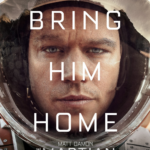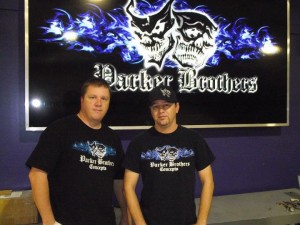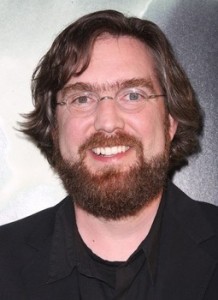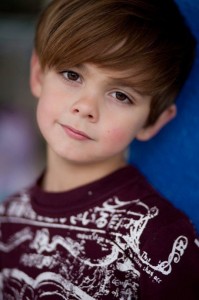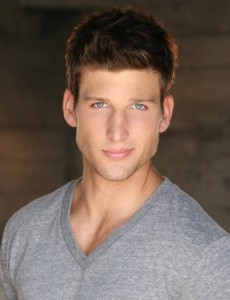As a child, there are moments that stick out in your life and often lead you in directions you would never have considered. For me, the date September 23, 1975 is one that will stay with me forever. It was on that day that I first saw the film, “Jaws.” For someone that wasn’t really a big movie-goer, I came out of that film with an enthusiasm for films that gave me both a career and a passion for more than 30 years. November 2007 saw the 30th Anniversary of another film favorite of mine, Steven Spielberg’s “Close Encounters of the Third Kind.” Spielberg, of course, also directed “Jaws” but the films also share another major talent, that of production designer Joe Alves.Artistically talented since he was a young man, Alves knew at a young age what career he wanted to pursue. A summer job got his foot in the door and from there he worked his way to the top of his profession, earning an Academy Award nomination for his work on “Close Encounters of the Third Kind.” He also designed the look of some of the most popular films of all time and even now his ideas help form the look of today’s films, most recently “I Am Legend.” From the famed Disney animation studio to “Night Gallery.” From Elvis to Jagger. From Junior Set Designer to Director, there isn’t anything Joe Alves hasn’t done on film. While preparing for a film seminar in Denmark, Mr. Alves took some time out to discuss his career and some of his best known films.
Click here to view our ‘Jaws” interview with Carl Gottlieb
Click here to view our ‘Jaws” interview with Keith Gordon
Click here to purchase “Jaws” merchandise
Mike Smith: It’s been 30 years since the release of “Close Encounters.” Did you think while you were filming that you would be talking about it three decades later?
Joe Alves: That’s always a hard question. I get the same question about “Jaws.” Let me just say that “Jaws” was different in the physical sense. With “Close Encounters,” there was a lot of buzz about it because the studio was behind it. The studio was having some financial problems and they needed a big picture. (note: The studio in question, Columbia, was in the middle of a mini-scandal after studio head David Begelman forged a $10,000 studio check he had written to Cliff Robertson. This incident caused a major upheaval at Columbia, both financially and artistically, that lasted for some time. Mr. Begelman committed suicide in 1995. The facts of this matter were documented in an excellent book, “Indecent Exposure.”) The movie started out very, very small. Steven (Spielberg) and I were skiing and preparing for a movie he was going to direct called “Bingo Long and His Traveling All-Stars,” which was a story about black baseball in the 1930s. I had taken a bunch of LIFE magazines and other research and we got snowed in. One night he started talking about “Watch the Skies,” which was based on a chapter of Dr. Hynek’s book (Dr. J. Allen Hynek, author of “The UFO Experience: A Scientific Study”), the chapter on Close Encounters of the Third Kind, where you had actual physical contact with aliens. And I didn’t know if he had a solid script yet or not but I said this sounds much more fascinating then this black baseball movie. Steven said, “yeah, but I don’t have a deal.” Anyway, when we got back to L.A. he got out of his deal to do “Bingo Long” and pursued a deal to do “Close Encounters.” Ironically another director I knew, John Badham, ended up getting “Bingo Long” and asked me to work on it. Steven got Julia and Michael Phillips (the producers of “CE3K”) interested and that was for Columbia. We had always worked at Universal. Anyway, eventually Steven got a deal and he put me on “Close Encounters.” I went over to Columbia and met John Veach, who was the head of production, and he said, “here’s what were going to do. It’s a $4 1/2 million picture. It’s a sci fi movie. And were going to do pretty much everything on the back lot.” But we needed an unusual piece of topography, since the script called for some kind of strange mountain. So they sent me off by myself to scout locations. And right at that time, “Jaws” opened, and Steven got very busy promoting “Jaws.” So I flew to Rapid City, South Dakota and I started driving all over what they call “scenic USA” looking for various odd pieces of topography. I had some notes to see various places; Devil’s Tower, Chimney Rock. So that was basically it, it was a small sci fi movie. Back then sci fi movies weren’t really big movies. They were important movies, films like “War of the Worlds” and “Forbidden Planet” were part of a cult following. Anyway, to answer your question the long way: no. We just thought we were making a very interesting movie.
MS: I’m glad you mentioned John Badham. I love John Badham. I wish he’d do more. (Readers: among my favorite John Badham films: “Saturday Night Fever,” “Dracula,” “Blue Thunder” and “American Fliers.” These days he works mostly in television, most recently on the series “Heroes.”)
JA: I’d known John for quite some time, in fact we worked on “Night Gallery” together, as did a lot of young directors at that time like Jeannot Szwarc. I did “Drop Zone” with John not too many years ago and we’ve always really had good communication. What happened with “Close Encounters” is what happens in Hollywood. “Jaws” became a big hit and that gave Steven confidence that he could make a bigger movie out of it, which got the studio thinking, “wow, we’ve got this brilliant director who made this movie about a shark that everybody thought was going to tank…the studio tried to cancel it four times…so maybe we have hope with “Close Encounters.” And it got bigger. We had started to break down the script to see what sets were needed and I came up with a huge arena and models of it. And the studio head took me to stage 15 and 16 at Warner Brothers, which is the “Camelot” stage, where they had made “Camelot,” and I said to him, “I don’t know if it’s big enough.” And he said “ah, you guys are just inflated by your “Jaws” movie,” and I said no, I’ll make up a model to fit in the stage and I’ll let you judge if it’s going to be big enough, because this is going to be an EVENT. A spaceship is going to come and land. This is going to be one of the most important events in world history. So I made the model and all of the executives came. Begelman was just starting with his problems so it was some of the old guard and some of the new guard…they all came in to look at the model. Now this movie was going to be the saving of the studio. So I gave my pitch and Steven and I told them we didn’t think the stages were big enough and they agreed. When they asked how big we thought it should be we told them four times bigger. So I made a model four times bigger, they came in and looked at it and said “this looks terrific, where are you going to do it?” And I said ‘I don’t have a clue.’ So then we started looking at airplane hangers and finally found the one in Mobile, Alabama. And that’s, briefly, how the thing sort of escalated. What was really difficult was that we needed new technology. We didn’t have that person. We had Lawrence Butler, who was the effects guy for Howard Hughes. He helped bring us up to what was available, like matte shots. We fumbled around for about six months and I did a lot of sketches of alien ships and finally we brought in Doug Trumbull, which escalated the budget more. In the meantime, down the street we had (George) Lucas doing “Star Wars” and they were developing some new technology. I mean we had John Dykstra and Doug Trumbull (working on separate projects) both developing this motion control technology. So it started very, very slow, first with just Steven and myself. Then they assigned a studio manager to do the budget. Michael Phillip was more active at the beginning then Julia Phillips. And after I came back with photographs of Devil’s Tower and other places Steven picked Devil’s Tower, which was my choice too. So I went and started scouting locations. I knew Vilmos (cinematographer Vilmos Zsigmond, who went on to win an Oscar for his work on “CE3K”) was going to be involved because he had done “Sugarland Express” with Steven. I think Steven originally asked him to do “Jaws” but he didn’t want to do a shark movie. And so Vilmos, Michael Phillips, Steven and I went to look at Devil’s Tower. When we came back I got the art department to start making models and that went on for a number of months. Six months later Trumbull came in with his group. We had decided we would use front projection, which created certain requirements from the art department regarding set pieces and things. But Larry Butler was important because he was the bridge between old technology and new technology.
MS: What led you to a career in film?
JA: Interesting question. I go back a long ways. High school in the early 50s. And I could always draw, from the time I can remember I was always drawing. In fact when I was in the fourth grade I drew all of the seven dwarfs. I can remember going to school and pinning them up on the wall. I was also a musician, I played piano. And in high school they would always have a rainy day amateur session. I’d play piano and others would twirl batons. And I ended up directing the senior extravaganza, which was a lot of different acts. So while I wasn’t really interested in acting I was interested in dramatics…music and art. And I saw a lot of movies. The movie that impressed me most was “An American In Paris.” And I remember coming out with the girl from up the street and I said, “Boy. That’s what I want to do.” I wanted to make movies and design things. So I pretty much decided at 15 or 16 that that’s what I wanted to do. When I went to college I majored in architecture and minored in drama. I then came down to L.A. and went to the Chouinard Art Institute, which was a fairly prestigious art school. It’s now become CalArts. Disney bought the thing. (Note: In 1961 brothers Walt and Roy Disney merged Chouinard and the Los Angeles Conservatory of Music into what is now CalArts). There I majored in motion picture design. Then it’s a real fluke. I needed a summer job and when I came home I talked to a fraternity brother whose father-in-law worked at Disney. So I thought I could give him a call and maybe get a job sweeping the stages. But, he happened to be the guy who did the hiring for the Disney artists and he asked me to bring in a portfolio. I didn’t think I was ready but he hired me and I was at Disney animation for a couple of years. That got me started but I decided I really wanted to work on live action. I started designing sets for a theater called the Hollywood Playhouse and got some recognition there. I built a portfolio and went to the studios. I started off as a junior set designer, then eventually assistant art director. Then art director. Production designer and occasional jobs as a director. And that’s how it went.
MS: You were 19 when you worked on “Forbidden Planet.” Did you look back on that experience when you were designing ideas for “Close Encounters?”
JA: Yes. It’s interesting that something I did so many years ago came back. Even more recently I did two animated movies (one being “Sinbad: Beyond the Veil of Mists”) and even though it was all computer it was the same process where we did a lot of rotoscoping and cell animation. But what you’re really doing is taking two items and putting them together. You’re taking live action and animation and putting them together. It’s the same with CGI, only it’s a little more trickier today. We used blue screen then. Today it’s green screen. We rotoscoped more then but today with CGI you can just blot things out… you don’t have to worry about the background so much. So the same technology applied to “Close Encounters” as to how we were going to put the spaceships in with the front projection. You’re still laying two elements on top of each other, but now you can layer multiple elements because you don’t lose generation. In fact, when we did “Close Encounters” we shot all of the effects in 65 mm so even though we lost a generation we’d be down to 35 mm so you wouldn’t get the degration in the film quality. And that’s the key. Of course, today, with digital, you don’t have to worry about it. When we did “Forbidden Planet,” we wanted to separate the animation…the cell animation with ink and paint…so we rendered everything on paper and we photographed it with the three color strips. So we never got that hard line of animation. We got a more realistic look.
MS: Like most people, I applauded at the end of “Jaws” when the shark is destroyed. But “Close Encounters” was actually the first film that I actually applauded when it ended. The mothership takes off, there is a few moments of silence and you’re sitting there stunned. And then “Directed by Steven Spielberg” hit the screen and the theater literally exploded. It’s a moment I’ll never forget. No matter how many times I watch it I still remember that moment.
JA: Which versions have you seen? All of them? (note: After the success of the film, Spielberg convinced the studio to finance a “Special Edition,” which allowed viewers to journey inside the mothership. Unfortunately, some of the funnier scenes from the original were edited out in this version. The recent 30th anniversary DVD release includes three versions of the film: the 1977 original, the 1980 special edition and a new version combining the 1977 original with five scenes from the Special Edition)
MS: I’ve seen all of them. I remember the original, we stood in line a total of six hours opening night between waiting to buy my ticket and then waiting to get into the auditorium. Getting back to the audience reaction, even though you worked on the film did you have the same kind of reaction when you finally saw the completed film?
JA: Oh yeah. You have all the elements. When you’re working on a film you see the dailies. Of course you don’t see them with music or with the color timing and the sound effects. And you don’t see them in continuity. So we’d see pieces of stuff. And then Doug’s (Trumbull) stuff came in so much later after we’d finished shooting. We were supposed to release “Close Encounters” before “Star Wars.” We were supposed to release it in late April but Doug didn’t get his stuff finished in time. And so we didn’t release until November. And we lost a little bit of impact because “Star Wars” had come out and blown everybody away with the visual effects. And I think because of the delay we lost the Academy Award for visual effects and art direction. I won the British Academy Award against “Star Wars.” A group of Brits, which was sort of interesting. Even Lucas, who came on our set, was blown away. He was like, “God, we never did anything like this…on this scale. We just did little sets and painted them. Most of it was visual effects.” But they were both well done and credible movies. To answer your question, I wasn’t happy with what Steven did later with the special edition.
MS:Thank you.
JA:I didn’t think there was a reason to go into the space ship.
MS:Thank you.
JA:Pardon?
MS:Thank you.
JA:To me it looked like a Holiday Inn I stayed at in Atlanta. You walk in and see all of these floors going up and I just didn’t know what the heck he was doing.
MS: And then they throw confetti on you.
JA: Yeah. I don’t know why but Steven went through a strange period where he kept redoing things. I don’t know why he did that…I just don’t have a clue. Because the ending was the end. There was nothing left to explain. In fact, I don’t even know why he did the last alien coming out. After I finished Steven kept redoing things. Rimbaldi (Carlo Rimbaldi, who designed the main alien for “CE3K” as well as the title creature in “Alien”) created that special alien which was really against what we had originally thought about. In the beginning we had thought about these really playful childlike aliens, which is why we used all these little kids. At one time we had them flying around all over the place touching people. It was a very scary looking alien which was contrary to what the little childlike aliens represented. That’s just my feeling about it. Some directors get to re-cut a movie because they get prestigious enough that they can release the cut that they wanted and not the one the studio wanted. But that wasn’t the case of “Close Encounters.” It was a movie that Steven couldn’t finish. You know what I mean?
MS:Sure. I mean, with Columbia needing the money at the time, “Close Encounters” was it’s big Christmas picture and they HAD to release it then. “Jaws” was delayed during shooting due to the many problems with the mechanical shark, yet you still turned out a pretty good movie. Did the knowledge that “Jaws” did so well despite problems make it easier on the “CE3K” set when the effects weren’t finished in time or you had to deal with unexpected delays?
JA: Not really, since most of Trumbull’s stuff was post production. I was on the film for almost a year before we started shooting. What Trumbull did on the first unit photography was get involved when we did the front projection in the hangar. The set was 450 feet long. When we shot over the set the front projection was important. There was a mountain that we called the “notch.” When Neary and Jillian climb up to the top of a knoll and look down and see the arena, I built that big rock they stand on. It was about seven stories high and was on big rollers. So when they climbed up, what they saw…what we see…is a front projection shot of the main set. We shot the main shots of the arena, with everybody walking around, in 65 mm. and then projected them. Doug was involved with that and with the shots of cars going off the road, things like that. So there wasn’t a lot of delays. After we wrapped principal photography we went back to L.A. and shot some more stuff there. A couple months later, after I was already working on “Jaws 2,” they shot a few more effects sequences, but the effects didn’t really delay principal photography at all.
MS: My understanding is that when Zanuck/Brown asked Spielberg to direct “Jaws 2” he agreed with the provision he be given another six months to finish “CE3K” before he started production. Did he ever bring up “Jaws 2” to you?
JA: Roy (Scheider) didn’t want to do “Jaws 2” but he was under contract. (Note: After “Jaws,” Scheider signed a three picture deal with Universal. His first film was William Friedkin’s “Sorcerer.” Film number two was supposed to be “The Deer Hunter.” However, after the script changed Scheider dropped out and was replaced by Robert DeNiro. Anxious for some continuity between the films, Universal offered to count Roy’s contract as fulfilled if he did “Jaws 2”). I think Richard (Dreyfuss) refused to be involved in it. And Zanuck/Brown, who were the hottest producers in Hollywood at the time with “The Sting” and “Jaws,” had asked me to work on “Jaws 2” and also be an associate producer of theirs, which was sort of prestigious at the time because they didn’t have associate producers like they do today and Zanuck and Brown never did. The also wanted me to direct the 2nd unit. So I went to Steven and he said, “I’d really like you to do “1941.” And he offered me the same thing Zanuck/Brown did. So I said OK but then he said he didn’t have a deal yet. And in Hollywood that’s sort of an awkward thing. You don’t turn down a sure film for a maybe. And I told Steven that I’d rather stick with him but I went on to do “Jaws 2.” And after the 2nd or 3rd week of shooting, they fired the director (John Hancock) and talked about canceling the picture. They asked me if I would go to Steven and show him the sketches I’d done and see if he would do “Jaws 2.” He said he’d consider it but wanted a million dollars and a big percentage and they said “no way.” So I’m working on “Jaws 2” when “Close Encounters” comes out. When I came back to California he asked me again to work on “1941.” He wanted to get rid of the production designer but I wasn’t comfortable. Then Steven went off to do “Raiders” and had to use a primarily British crew. He eventually started using different people which was fine because I wanted to direct.
MS:Which brings me to my next question. As the director of “Jaws 3-D,” was the original concept of the film to be presented in 3-D or was that developed later?
JA: I was in Japan working on a film called “The Ninja” for Zanuck/Brown. Marvin Davis bought 20th Century Fox studios, it was a Fox movie, and ended up canceling most of the films that hadn’t started shooting. So I came back to Hollywood and Verna Fields (the Oscar-winning film editor of “Jaws,” later an executive at Universal) called me and said, “you know, they’re doing “Jaws 3″ and they’re making a mess. They’ve got a dumb script and Zanuck/Brown don’t want anything to do with it. I really think you should get involved. They’ve got a TV producer who bought the rights doing it.” So I went to see Alan Landsberg and he asked if I wanted to produce it. I said no, I’d already done that. I directed 100 days of the 2nd unit on “Jaws 2” and I’d be interested in directing it. He said he’d think about it and asked if I’d work with Richard Matheson, the writer, and see what develops. Richard and I were scouting theme parks because the film was written with a Sea World type theme park environment. And while we were at a park in Florida we saw an exhibit of underwater 3-D photography. And I just loved it, the depth of it. It really bothered me that we were doing a “3.” There weren’t really a lot of “3’s” out there, maybe “Rocky III,” people weren’t as gracious to sequels at that time, which has really changed in recent years. Then it just hit me…JAWS…3…D. That would take the onus off of the “3.” So I made a sketch of the shark coming at us and put “3-D” around it and he liked it and said to take the idea to Sid Sheinberg (the head of Universal at the time). Sid said “this is great, let me show it to Wasserman (Universal/MCA big man Lew Wasserman). So now Universal was very interested in the project. So now I’m going to direct it and I discover that there is no new 3-D equipment…nothing since “Bwana Devil” in the 1950s. So we had to make new cameras. So, no, it didn’t start off as “Jaws 3-D.”
MS: Another film you designed the look for was John Carpenter’s “Escape From New York.” I recently saw “I Am Legend” and couldn’t help but notice a great similarity between their futuristic view of Manhattan and yours, especially in the night scenes. Is it a good feeling to know that your work is still influencing filmmakers a quarter century later?
JA: “Escape” was a very interesting movie. It was a low budget film and my agency was also the agency for John and Debra (the late Debra Hill, Carpenter’s producer). I had just gone through some unfortunate things. I was going to direct a big budget Formula One racing movie. We had scouted locations and were ready to go but then the financing fell apart so the picture wasn’t made. My agent called me and said he had the young filmmakers of “Halloween.” They were going to make a bigger movie and he thought they could use my help. So it turned out to be a good thing. The film’s look was well received by the critics.
MS:This past summer I was on Martha’s Vineyard and Edith Blake (local photographer/journalist who wrote a book detailing the making of “JAWS”) showed me some photos she had taken during the early production days of “Jaws 2” when John Hancock was still on board. The town looked deserted and the mood was pretty dark. How much of the film’s tone changed when Jeannot Szwarc took over?
JA: A lot. John’s concept, and one Jeannot held onto for awhile, was to make a very depressing movie…the shark had put everything into the depths of hell. The economy died because no one was visiting the beaches anymore. It was maybe a little over the top…the colors we had were very somber. Zanuck was never really happy with that concept anyway so when Jeannot came in we threw it out and made it so three years had passed and everything was back together except for Brody, who was paranoid. So we just played on Roy’s paranoia, that the shark was always out there and people were just ignoring it and the kids were having fun. So definitely a big concept change.”
MS:Looking back on “Night Gallery,” was Rod Serling as brilliant in person as he was in his writing?
JA:He was an extremely nice guy. We would see Rod every once in awhile when he would come in to film the introductions. He was a very, very positive guy. I liked him a lot. He was very complimentary to us in the art department…what we were doing visually. He’d always say “you guys are terrific.” Which was very uplifting for me being one of the younger guys on the crew.
MS:I must confess that one of my favorite Elvis films is “Change of Habit.”
JA:Are you serious?
MS:Yes. I don’t know why. Maybe it’s the whole “rage reduction” scene. Did you get a chance to talk with him?
JA:Elvis was not the friendliest of guys. He was not very well prepared and Mary Tyler Moore was always sort of pissed at him because he didn’t know his lines. When I worked on “Freejack” with Mick Jagger, Mick was very friendly. Elvis was constantly guarded by his entourage. I know he came off like a warm person but he was pretty well guarded so you didn’t have a chance to hang with him. He would be with his entourage, come on the set, do his lines and then head back to his trailer. Even his fellow actors felt distant from him.
MS:Finally, what’s next for you? When we spoke earlier you were preparing to give a seminar in Denmark.
JA: I’m going to Denmark. A film composer there met a friend of mine and started naming off some of his favorite films and somehow my name came up. My friend told him he had gone to school with me and had played in my band. So here’s a guy in Copenhagen that had played trumpet for me 50 years ago talking to a composer who knows my name. The composer came over here to look for work and we met and he said, boy, it would be great if you could come do a seminar in Denmark. So he contacted the film institute there and they asked if I could come so I’m going to go do an eleven hour lecture, which is going to be a handful. I’ll probably do a day on “Jaws” and a day on “Close Encounters.” I did a five-hour lecture in Kuala Lampoor, Malaysia, a few years ago, so I think I’ll be OK.
Photos on this page are used for illustrative and promotional purposes only and are the property of the copyright holders.
Click here to purchase “Jaws” merchandise
